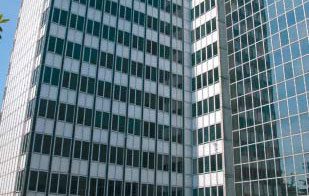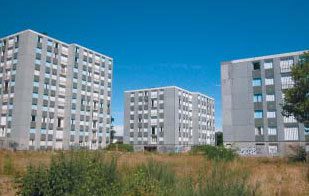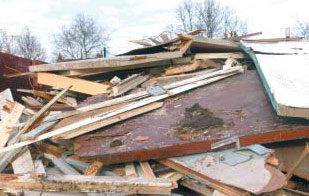In France, 2 different categories of buildings were chosen for investigation.
Research on building scrap collection rates in Europe, conducted by Prof Udo Boin of Delft University of Technology in 2003, identified two different categories of buildings for investigation in France: a 13-storey commercial building, the Elf Tower in Pau and two residential buildings in Le Mans.
Demolition in both locations was undertaken by Delair Navarra, a large and well-respected ISO-certified company, working extensively all over France. ISO (International Organization for Standardization) certification ensures the implementation of work practices in strict adherence with legal standards, a vital consideration for the contractor, who is ultimately liable.
Commercial Building, Pau
In Pau, the main objective was to obtain a clean concrete mass to be used on site as fill material to build a new office building. After removal of hazardous materials including lighting structures and semi-hazardous materials such as gypsum boards, demolition was conducted according to a “folding” process. This method, whereby the walls of the building are folded inwards like the sides of a box, ensures optimal recovery of valuable materials such as aluminium.
Large quantities of aluminium were thus collected from the exterior profiles after demolition, amounting to two-thirds of the total aluminium recovered. The fact that clean concrete rubble was required for the new on-site construction meant that the concrete had to be stripped completely bare of all foreign materials, which served to boost aluminium collection rates.
A significant share of the aluminium in the building (13%) was contained in the interior sun blinds, 100% of which was collected for recycling. A number of heavily corroded windows from the original construction had also been replaced with aluminium windows or repaired with aluminium strips, as aluminium is corrosion resistant and therefore ideal for this purpose.
As much as possible was recovered and sorted to a special container where hand-cleaned aluminium was readied for shipment. Indeed, all the materials were collected in special bins placed around the building to ensure maximum recovery. Highly accurate stripping and sorting of aluminium thus yielded a collection rate of 92% from an overall aluminium share totalling 0.064% of the building mass (640g per tonne).
Residential building, Le Mans
In Le Mans, the deconstruction and demolition of two identical apartment buildings dating from 1971 revealed very low aluminium content, constituting only 0.0018% of the total building mass (18g per tonne). This low concentration, consisting typically of a variety of small objects, was disseminated over a large area, making collection very laborious.
Since the principal objective of the demolition was to obtain a clean and reusable concrete fraction, a significant percentage of aluminium was lost, as most of the components were attached to other materials. For example, door handles, accounting for more than 50% of the total aluminium content, were not separately collected but grouped together with waste wood which was incinerated or dumped and buried.
Therefore, due to the complete lack of large aluminium structures, like windows, profiles and exterior cladding, and the extensive dissemination of small objects, which were not the primary focus of the demolition contractor, the collection rate in this instance was only 31.



